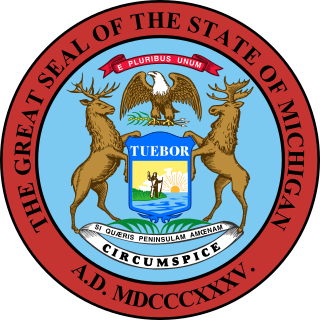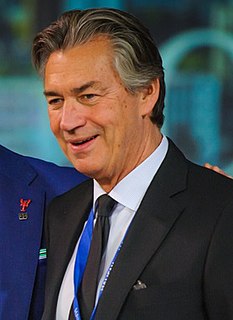The Vermont General Assembly is the legislative body of the state of Vermont, in the United States. The Legislature is formally known as the "General Assembly," but the style of "Legislature" is commonly used, including by the body itself. The General Assembly is a bicameral legislature, consisting of the 150-member Vermont House of Representatives and the 30-member Vermont Senate.
Members of the House are elected by single and two-member districts. 58 districts choose one member, and 46 choose two, with the term of service being two years. The Senate includes 30 Senators, elected by 3 single-member and 10 multi-member districts with two, three, or six members each. It is the only state legislative body in the United States in which a third-party has had continuous representation and been consecutively elected alongside Democrats and Republicans.

The New York State Legislature consists of the two houses that act as the state legislature of the U.S. state of New York. The New York Constitution does not designate an official term for the two houses together. It says only that "legislative power is vested in the senate and assembly." The session laws are published in the official Laws of New York. The permanent laws of a general nature are codified in the Consolidated Laws of New York. The legislature is seated at the New York State Capitol in Albany.

The New York State Assembly is the lower house of the New York State Legislature, the New York State Senate being the upper house. There are 150 seats in the Assembly, with each of the 150 Assembly districts having an average population of 128,652. Assembly members serve two-year terms without term limits.

The Minnesota Legislature is the bicameral legislature of the U.S. state of Minnesota consisting of two houses: the Senate and the House of Representatives. Senators are elected from 67 single-member districts. In order to account for decennial redistricting, members run for one two-year term and two four-year terms each decade. They are elected for four-year terms in years ending in 2 and 6, and for two-year terms in years ending in 0. Representatives are elected for two-year terms from 134 single-member districts formed by dividing the 67 senate districts in half.

The Michigan Senate is the upper house of the Legislature of the U.S. State of Michigan. Along with the House of Representatives, it composes the Michigan Legislature. Article IV of the Michigan Constitution, adopted in 1963, defines the role of the Legislature and how it is to be constituted. The primary purpose of the Legislature is to enact new laws and amend or repeal existing laws.

The Tennessee General Assembly (TNGA) is the state legislature of the U.S. state of Tennessee. It is a part-time bicameral legislature consisting of a Senate and a House of Representatives. The Speaker of the Senate carries the additional title and office of Lieutenant Governor of Tennessee. In addition to passing a budget for state government plus other legislation, the General Assembly appoints three state officers specified by the state constitution. It is also the initiating body in any process to amend the state's constitution.

The Mississippi Senate is the upper house of the Mississippi Legislature, the state legislature of the U.S. state of Mississippi. The Senate is composed of 52 senators representing an equal amount of constituent districts, with 54,704 people per district. Senators serve four-year terms with no term limits.

The Legislature of Guam is the law-making body for the United States territory of Guam. The unicameral legislative branch consists of fifteen senators, each serving for a two-year term. All members of the legislature are elected at-large with the island under one whole district. After the enactment of the Guam Organic Act in 1950, the First Guam Legislature was elected composing of 21 elected members. Today, the current fifteen-member 35th Guam Legislature was elected in November 2018.

The National Popular Vote Interstate Compact (NPVIC) is an agreement among a group of U.S. states and the District of Columbia to award all their electoral votes to whichever presidential candidate wins the overall popular vote in the 50 states and the District of Columbia. The compact is designed to ensure that the candidate who receives the most votes nationwide is elected president, and it would come into effect only when it would guarantee that outcome. As of March 2019, it has been adopted by thirteen states and the District of Columbia. Together, they have 184 electoral votes, which is 34.2% of the Electoral College and 68.1% of the 270 votes needed to give the compact legal force.

The Manitoba general election held on May 22, 2007 was held to elect Members of the Legislative Assembly of the Province of Manitoba, Canada. It was won by the New Democratic Party, which won 36 seats out of 57. The Progressive Conservative Party finished second with nineteen seats. The Liberal Party won two seats. As a result, Premier of Manitoba Gary Doer received a mandate to form a third consecutive majority government, becoming the first Premier of Manitoba to achieve this since Duff Roblin in 1966.

The 1837 general election organized the fourth legislature of the July Monarchy. The election was held on 4 November.

The 2010 United States elections were held on Tuesday, November 2, 2010, in the middle of Democratic President Barack Obama's first term. During this midterm election year, all 435 seats in the United States House of Representatives and 37 of the 100 seats in the United States Senate were contested, along with 39 state and territorial governorships, 46 state legislatures, four territorial legislatures and numerous state and local offices. Approximately 82.5 million people voted.

The Tamil Nadu Legislative Assembly alone has powers to legislate laws covering state subjects in the Indian state of Tamil Nadu. It has a strength of 235 members of whom 234 are democratically elected using the First-past-the-post system. The remaining member is nominated as a representative of the Anglo-Indian community. The presiding officer of the Assembly is called the Speaker. The term of the Assembly is five years unless it is dissolved earlier.
The 1789 United States Senate election in New York was held in July 1789 to elect two U.S. Senators to represent the State of New York in the United States Senate. It was the first such election, and before the actual election the New York State Legislature had to establish the proceedings how to elect the senators.
The 1827 United States Senate election in New York was held on February 6, 1827, by the New York State Legislature to elect a U.S. Senator to represent the State of New York in the United States Senate.
The 1833 United States Senate election in New York was held on February 5, 1833, by the New York State Legislature to elect a U.S. Senator to represent the State of New York in the United States Senate.
The United States Senate elections of 1850 and 1851 were elections which had the Democratic Party lose seats, but retain a majority in the United States Senate.

The Jammu and Kashmir Legislative Assembly also known as the Jammu and Kashmir Vidhan Sabha is the lower house of the bicameral legislature of the Indian state of Jammu and Kashmir, which is known as the Jammu and Kashmir State Legislature. It has 87 members.

The 176th New York State Legislature, consisting of the New York State Senate and the New York State Assembly, met from January 5 to July 6, 1966, during the eighth year of Nelson Rockefeller's governorship, in Albany.

The 2020 United States elections will be held on Tuesday, November 3, 2020. All 435 seats in the United States House of Representatives, 34 of the 100 seats in the United States Senate, and the office of President of the United States will be contested. Thirteen state and territorial governorships, as well as numerous other state and local elections, will also be contested.


















